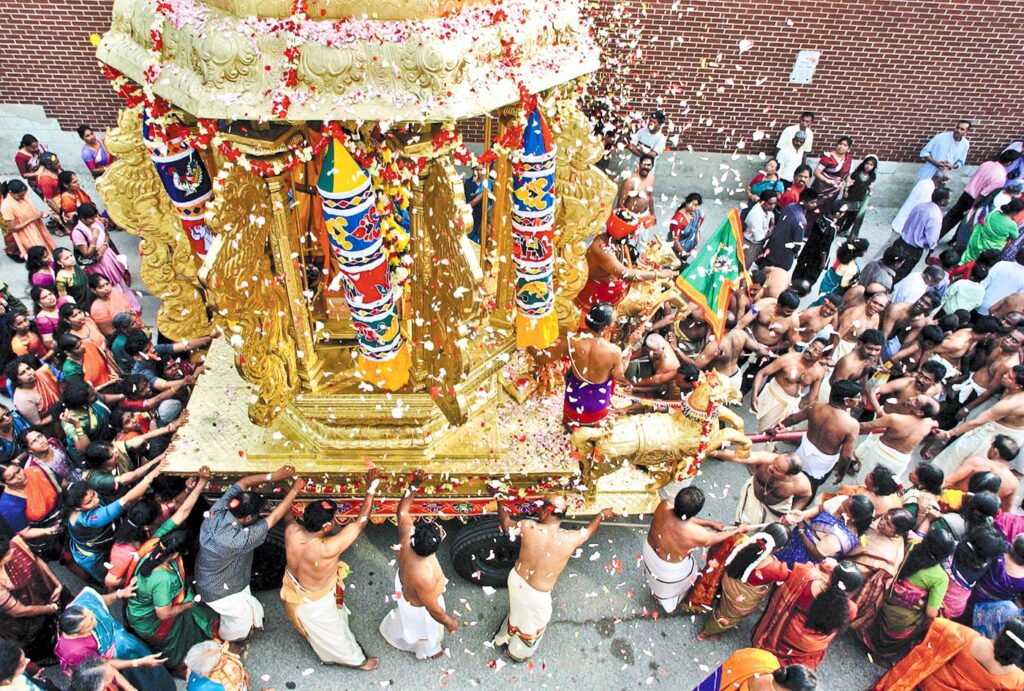JOYOUS OCCASIONS THAT ARE THE HEART AND SOUL OF SANATANA DHARMA
Hinduism is celebratory by nature. Hindus miss no opportunity to set mundane matters aside and join with family, friends, neighbors and strangers alike to feast and have fun, to renew the home and the heart and, most importantly, draw nearer to God.
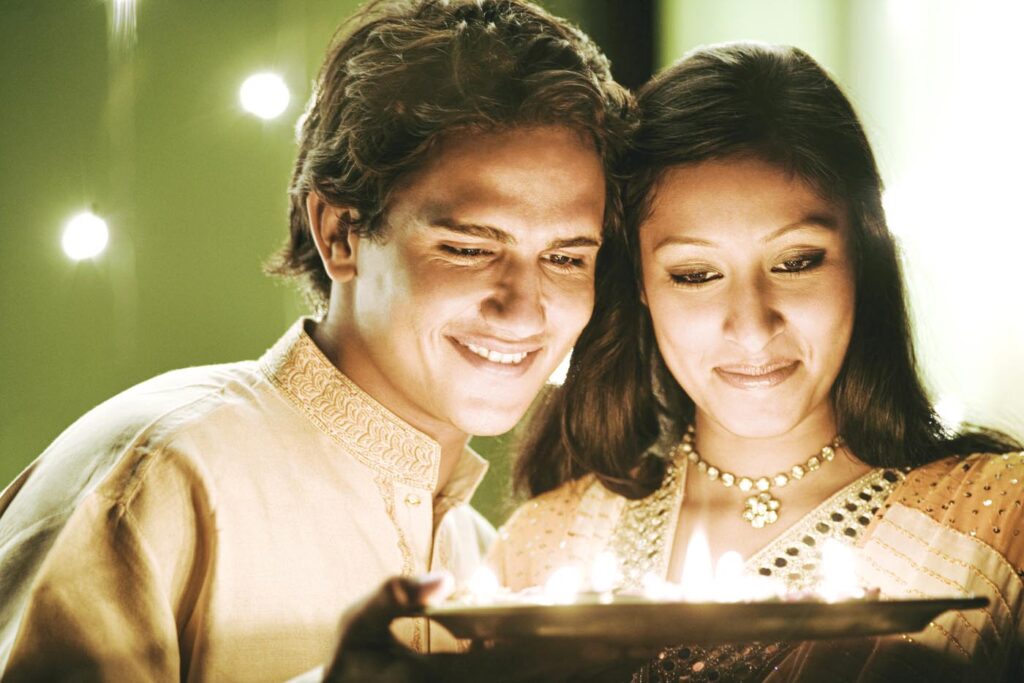
Festivals are perhaps more impressive and varied in Hinduism than in any other religion. The devout Hindu knows these are times of profound mysticism, when God and the Gods touch our world, revitalize our souls, lighten karmas and bless our families.
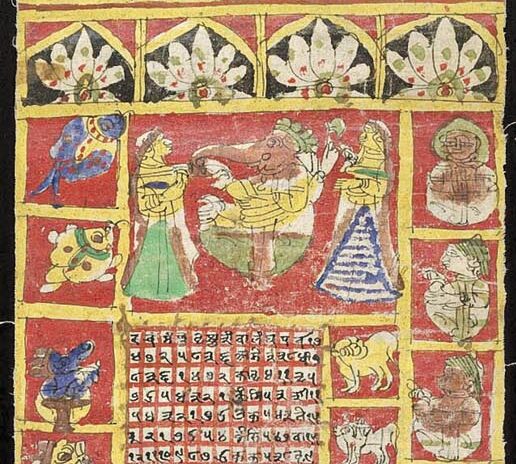
Yet festivals do even more than this: they are essential to the perpetuation of religion, periodically reigniting the spark of zeal and devotion in the community. They provide the spiritual public square where Hindus engage with one another, affirming shared values and enjoying life’s intersections.
Before each celebration, vows are taken, scriptures are studied, pilgrimages are trodden and fasts observed in preparation—all individual acts of intimate devotion that bring the devotee closer to the Gods and keep him on the path to his inmost Self. As each festival begins, solitary adoration becomes a collective ritual, with millions of people taking their places in an ad-hoc choreography. Tradition is followed, but the result is never the same: every festival is special and unforgettable in its own way.
Thus the Hindu is reminded of his faith by the sounds, scents and the wild medley of tastes laid out for the feast. His mind and emotions are imbued with Hinduism as sacred mantraprayers are intoned, the spiritual teachings are recounted by saints, and the Gods are praised in melodious bhajans.
Each state of India, indeed each village, lends a little of its unique culture to how a festival is celebrated, creating almost endless variations. Recently, with the growing Hindu population outside of India, festivals have acquired an international dimension. They provide a window into Hinduism for the non-Hindu populations in countries as far flung as Norway, Chile and Canada. At the same time, for Hindus immersed in foreign and often very alien cultures, festivals are the most visible and memorable sign of their heritage. Celebrated with unmatched fervor but with paced regularity, festivals serve as a reminder of one’s identity and allegiance to Hindu traditions and ideals.
What could be more entertaining, alive, vibrant and yet pious and rich in symbolism than a Hindu festival? Professor Dr. Shiva Bajpai remarked that it is through festivals that most Hindus experience their religion: “Festivals, pilgrimages and temple worship are the faith armor of Hindus.”
Hindu Festivals For the Media
Join Hinduism Today in educating the press with accurate and uplifting information about Hinduism
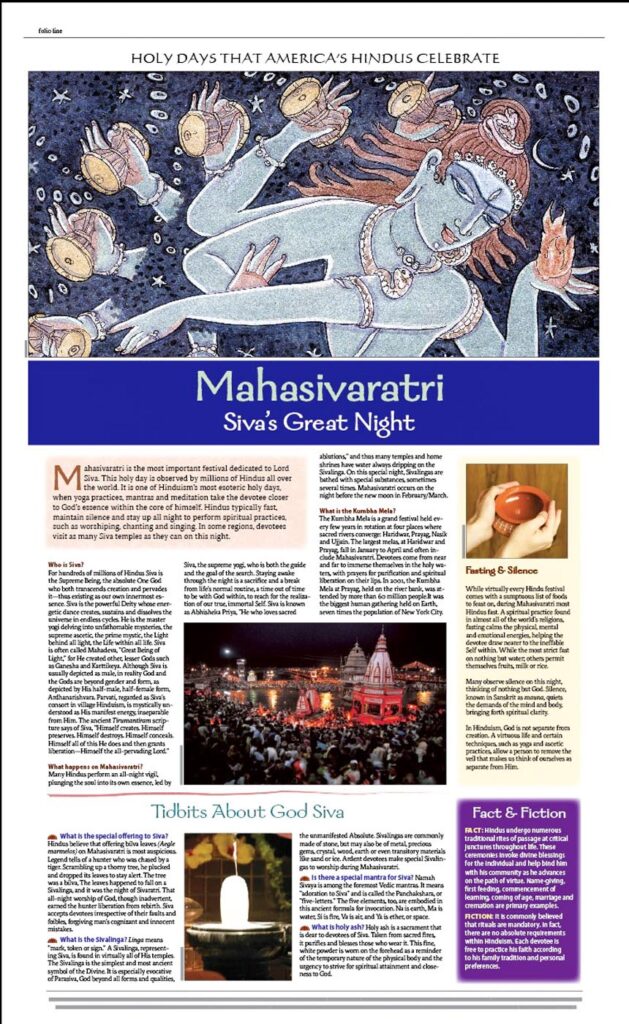
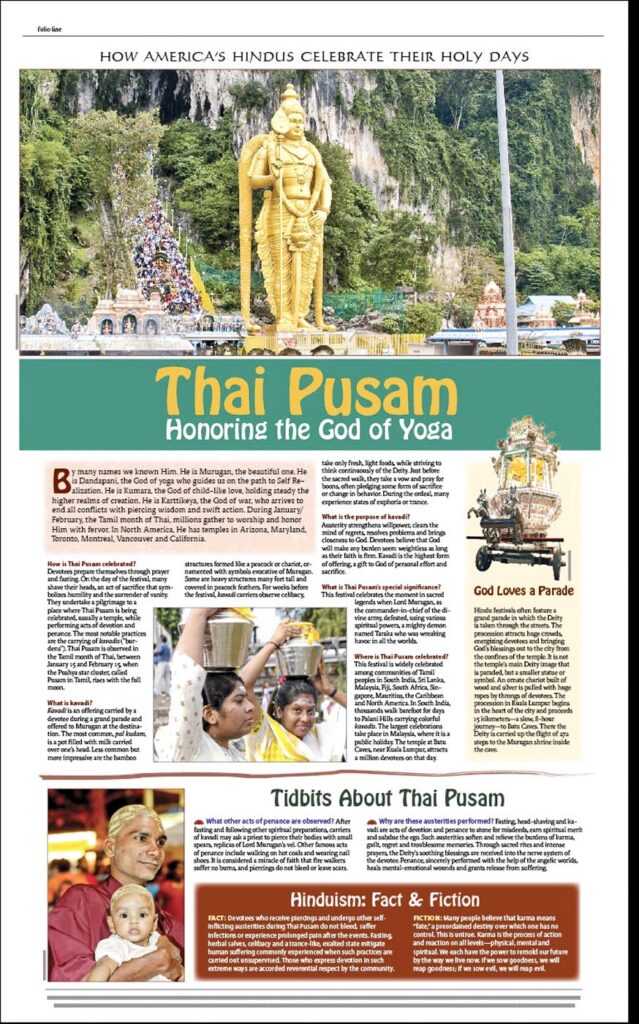
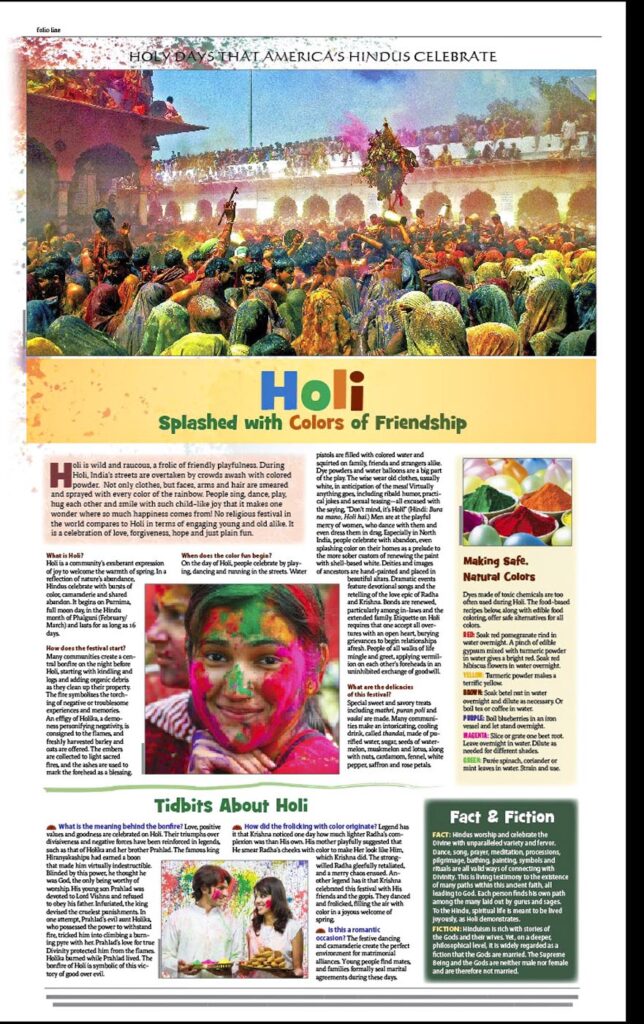
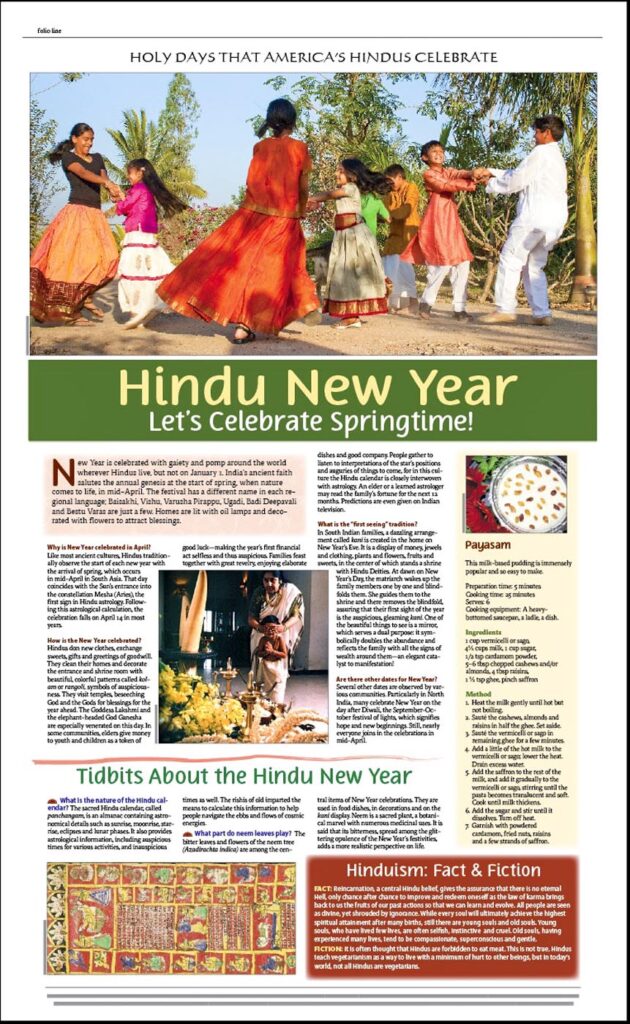
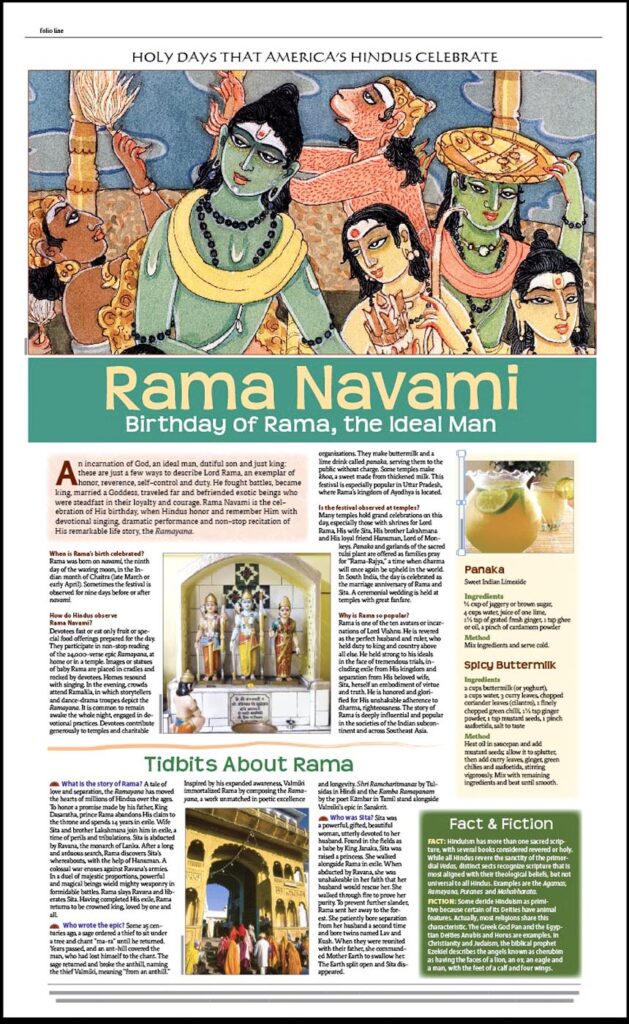
Imprecise information, unflattering photos and an obsession for the bizarre are common when the media features our faith. For most Hindus, there seems little or nothing that can be done about this, except to practice detachment and soulful acceptance. That was the tone at a 2007 Hindu conference in Dallas, Texas, until suddenly the leaders collectively declared, “Enough.” Determined to complain less and do more, they masterminded the Hindu Festival Media Initiative, a strategic project designed by Hinduism Today in collaboration with the Sanatana Dharma Foundation.
There could be no better time to educate the public about Hindu religion and culture. In 2009, for example, President Obama attended the first Diwali celebration at the White House, an historic moment, complete with Sanskrit chants by a Hindu priest in full garb. Yet, not a single media report rightly explained the festival of lights; a proper description of the festival was found only in the president’s brief but inspired speech.
The Pager Project: We selected fifteen major festivals as the core of the project (of which six are in this Insight). Then, collaborating with Soumya Sitaram posters of Bengaluru, we created a series of “pagers”—ready-to-print, newspaper-sized resources. They match standard US newspapers in journalistic style and size, making them easy to use, especially for publishers with limited staff. Each pager highlights a festival in its celebratory, community and family aspects. In the “Fact and Fiction” section and elsewhere, the pagers introduce Hindu philosophical, cultural and spiritual ideas. These resources can also be sent to bloggers and digital publishers, who can repurpose them for their audience.
How the Program Works: Newspapers (especially in these days of budgetary cutbacks) welcome input from faith communities if the material is of high editorial quality, with polished text and eye-catching photos, especially if it’s free. Motivated Hindus are encouraged to approach their local newspapers’ religion or lifestyle editors with the appropriate pager in the weeks before each festival. Editors may elect to use them as is, or draw from the graphics and words and adapt them to their own style. Television and public radio stations can also be approached; the pagers can provide a comprehensive and authentic summary for voice-overs. They are available on the web as teaching resources for families, schools, summer camps, temples, ashrams, bloggers, etc.
How You Can Participate: Talk to your local temple board, the local Hindu association and newspapers in your area. Visit www.hinduismtoday.com/festivals for more information. There you will find all the pagers in PDF format, with instructions on how to best use them. No matter where you live, these festival summaries will provide your local media with informative, factual information about your faith. By preemptively explaining how Hindus experience and understand Sanatana Dharma, we bridge the we/they cultural gap, proactively bringing more tolerance, acceptance and understanding into the world.
Hindu New Year
Let’s Celebrate Springtime!
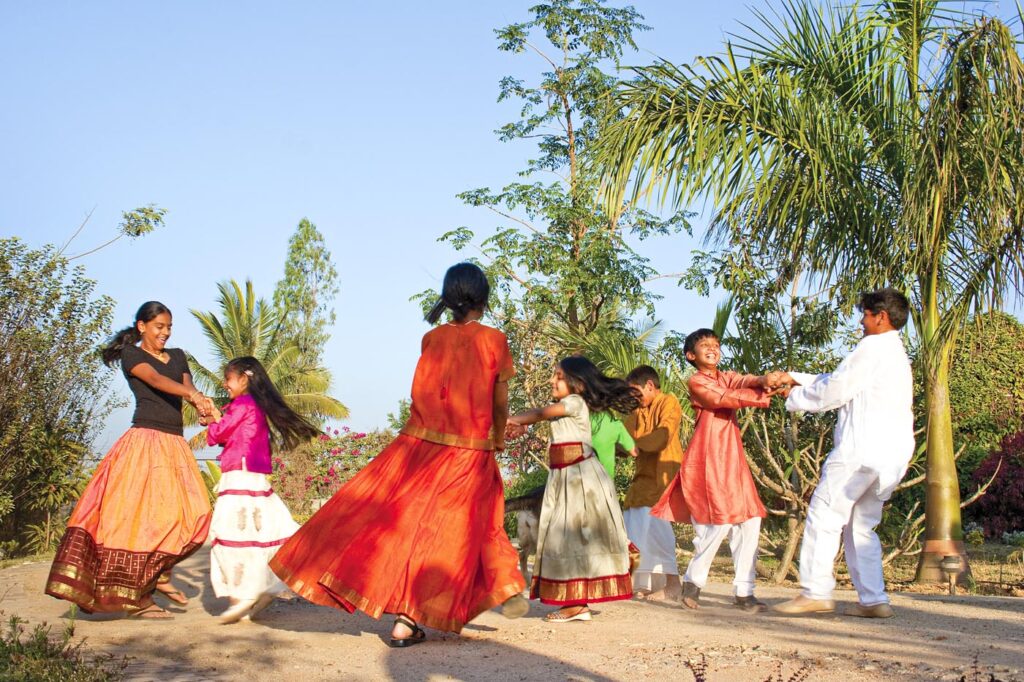
New Year is celebrated with gaiety and pomp around the world wherever Hindus live, but not on January 1. India’s ancient faith salutes the annual genesis at the start of spring, when nature comes to life, in mid-April. The festival has a different name in each regional language: Baisakhi, Vishu, Varusha Pirappu, Ugadi, Badi Deepavali and Bestu Varas are just a few. Homes are lit with oil lamps and decorated with flowers to attract blessings.
Why is New Year celebrated in April?
Like most ancient cultures, Hindus traditionally observe the start of each new year with the arrival of spring, which occurs in mid-April in South Asia. That day coincides with the Sun’s entrance into the constellation Mesha (Aries), the first sign in Hindu astrology. Following this astrological calculation, the celebration falls on April 14 in most years.
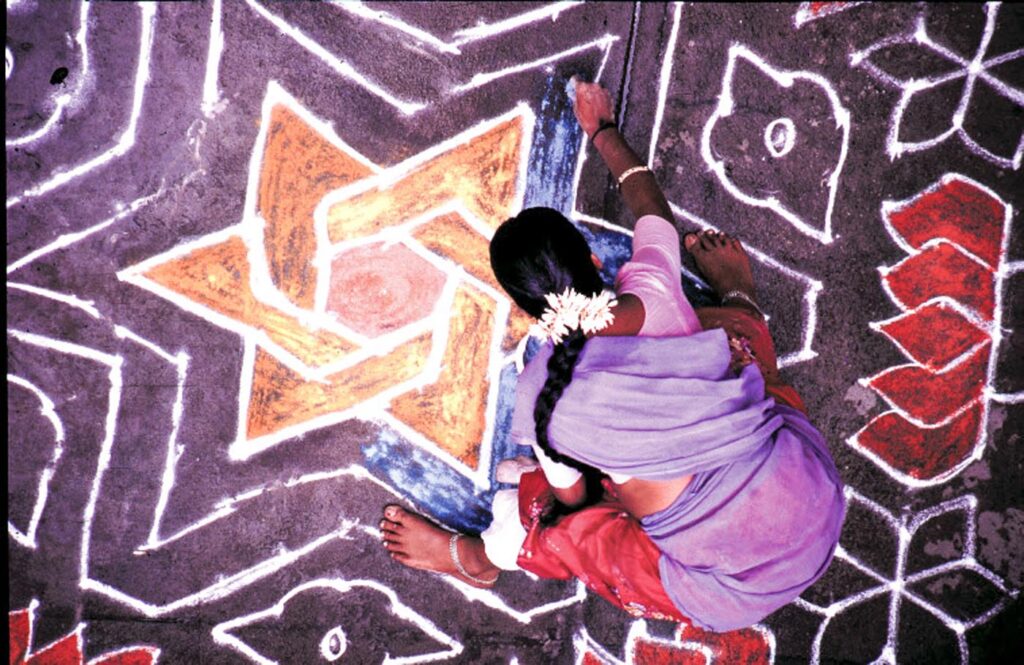
How is the New Year celebrated?
Hindus don new clothes and exchange sweets, gifts and greetings of goodwill. They clean their homes and decorate the entrance and shrine room with beautiful, colorful patterns called kolam or rangoli, symbols of auspiciousness. They visit temples, beseeching God and the Gods for blessings for the year ahead. The Goddess Lakshmi and the elephant-headed God, Ganesha, are especially venerated on this day. In some communities, elders give money to youth and children as a token of good luck—making the year’s first financial act selfless and thus auspicious. Families feast together with great revelry, enjoying elaborate dishes and good company. People gather to listen to interpretations of the stars’ positions and auguries of things to come, for the Hindu calendar is closely interwoven with astrology. An elder or learned astrologer may read the family’s fortune for the next 12 months. Predictions are even given on Indian television.
What is the “first seeing” tradition?
In South Indian families, a dazzling arrangement called kani is created in the home on New Year’s Eve. It is a display of money, jewels and clothing, plants and flowers, fruits and sweets, in the center of which stands a shrine with Hindu Deities. At dawn on New Year’s Day, the matriarch wakes up the family members one by one and blindfolds them. She guides them to the shrine and there removes the blindfold, assuring that their first sight of the year is the auspicious, gleaming kani. Increasing the significance is a mirror, which serves a dual purpose: it symbolically doubles the abundance and reflects the family with all the signs of wealth around them—an elegant catalyst to manifestation!
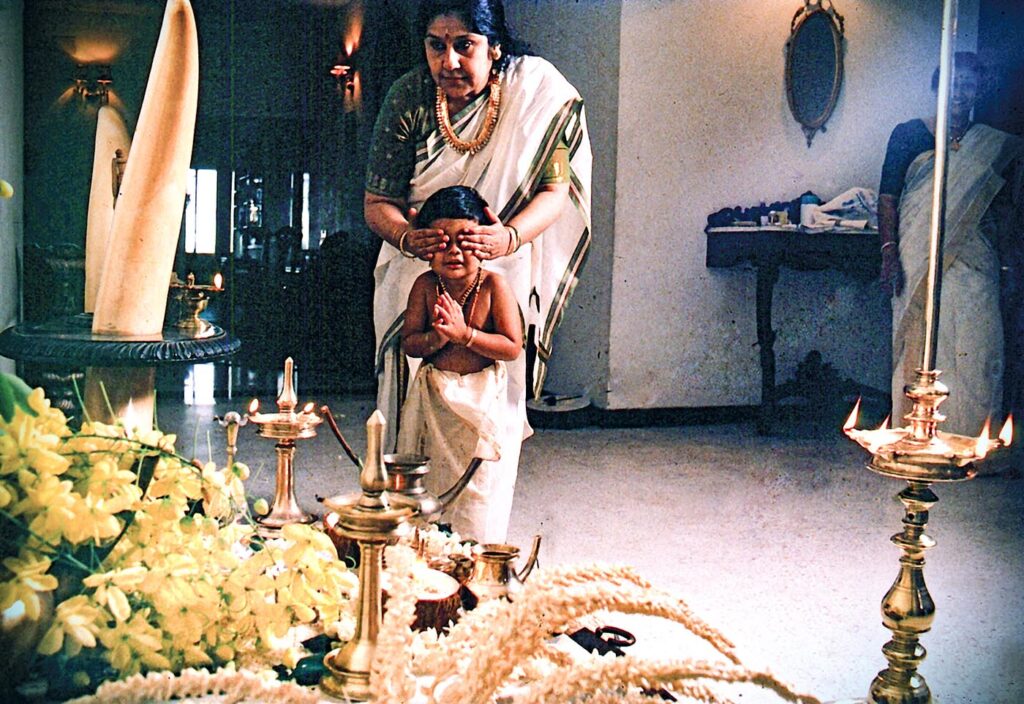
Tidbits About the Hindu New Year
✿ What is the nature of the Hindu calendar? The sacred Hindu calendar, called panchangam, is an almanac containing astronomical details such as sunrise, moonrise, star-rise, eclipses and lunar phases. It also provides astrological information, including auspicious times for various activities, and inauspicious times as well. The rishis of old imparted the means to calculate this information to help people navigate the ebbs and flows of cosmic energies.
✿ What part do neem leaves play? The bitter leaves and flowers of the neem tree (Azadirachta indica) are among the central items of New Year celebrations. They are used in food dishes, in decorations and on the kani display. Neem is a sacred plant, a botanical marvel with numerous medicinal uses. It is said that its bitterness, spread among the glittering opulence of the New Year’s festivities, adds a more realistic perspective on life.
Hinduism: Fact & Fiction
FACT: Reincarnation, a central Hindu belief, gives the assurance that there is no eternal Hell, only chance after chance to improve and redeem oneself as the law of karma brings back to us the fruits of our past actions so that we can learn and evolve. All people are seen as divine, yet shrouded by ignorance. While every soul will ultimately achieve the highest spiritual attainment after many births, still there are young souls and old souls. Young souls, who have lived few lives, are often selfish, instinctive and cruel. Old souls, having experienced many lives, tend to be compassionate, superconscious and gentle.
FICTION: It is often thought that Hindus are forbidden to eat meat. This is not true. Hindus teach vegetarianism as a way to live with a minimum of hurt to other beings, but in today’s world, not all Hindus are vegetarians.
Payasam
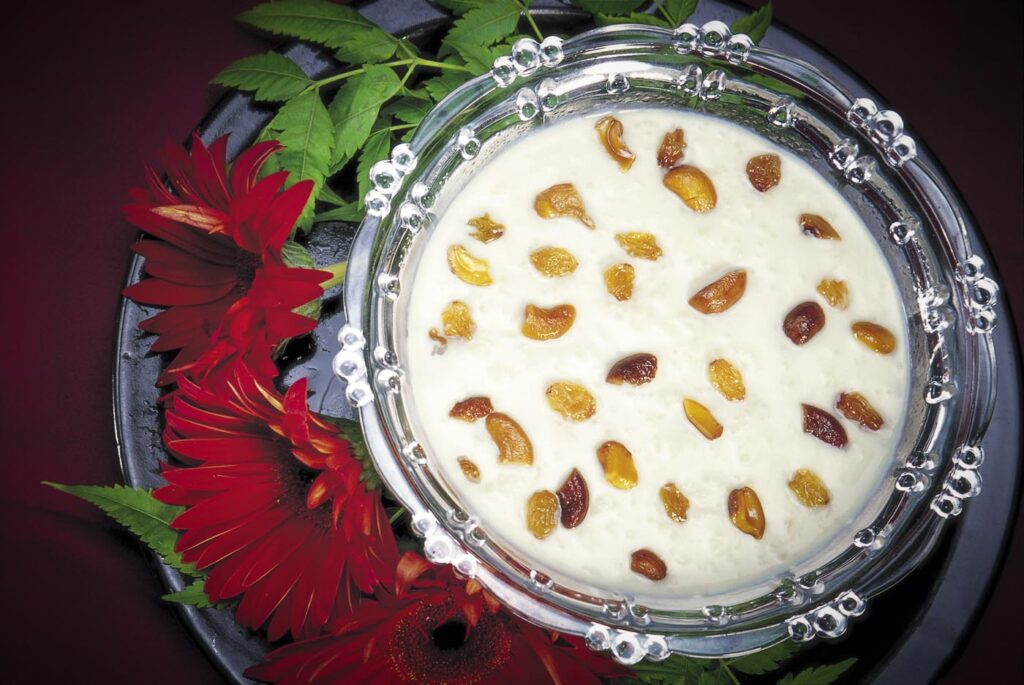
This milk-based pudding is immensely popular and so easy to make.
Preparation time: 5 minutes
Cooking time: 25 minutes; Serves: 6
Cooking equipment: A heavy-bottomed saucepan, a ladle, a dish.
Ingredients
1 cup vermicelli or sago
4½ cups milk
1 cup sugar
1/2 tsp cardamom powder
5–6 tbsp chopped cashews and/or almonds
4 tbsp raisins
1 ½ tsp ghee, pinch of saffron
Method
1. Heat the milk gently until hot but not boiling.
2. Sauté the cashews, almonds and raisins in half the ghee. Set aside.
3. Sauté the vermicelli or sago in remaining ghee for a few minutes.
4. Add a little of the hot milk to the vermicelli or sago; lower the heat.
5. Add the saffron to the rest of the milk, and add it gradually to the vermicelli or sago, stirring until the pasta becomes translucent and soft. Cook until milk thickens.
6. Add the sugar and stir until it dissolves. Turn off heat.
7. Garnish with powdered cardamom, fried nuts, raisins and a few strands of saffron.
Krishna Jayanti
Birthday of the God of Divine Love
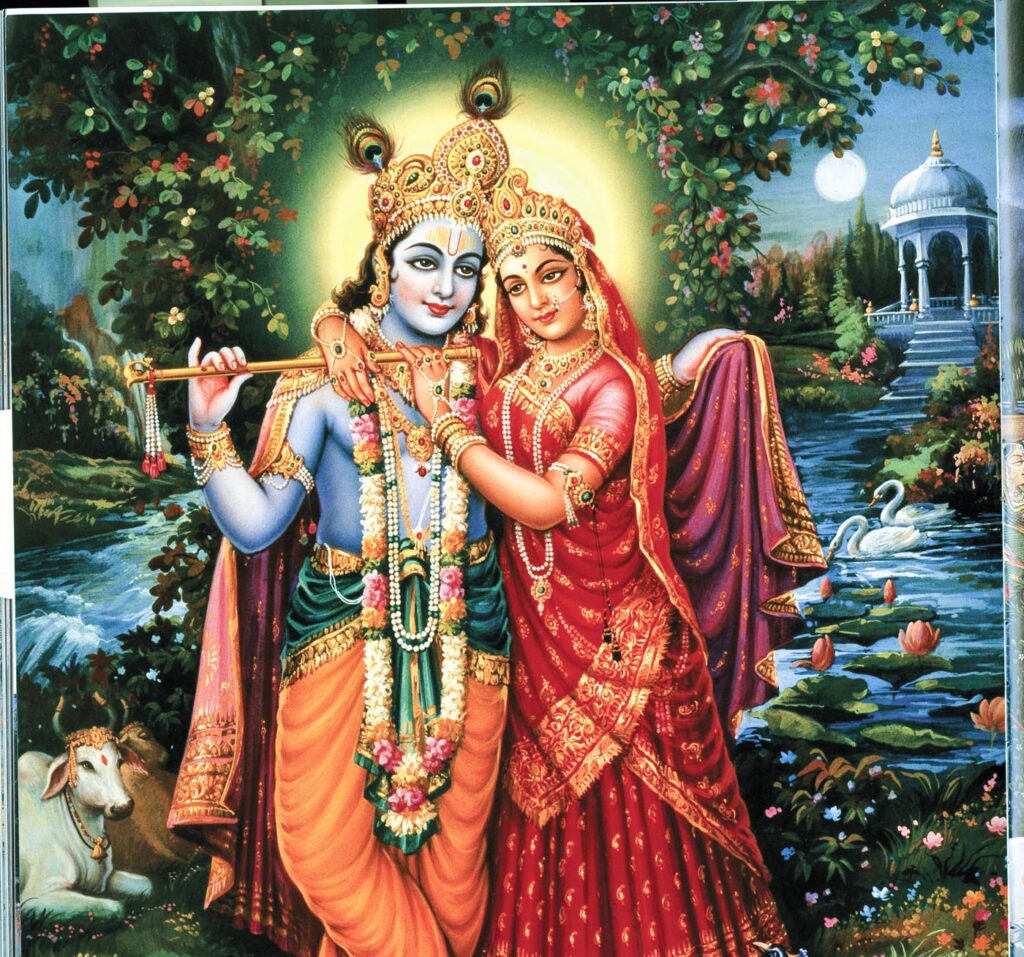
Krishna, the preeminent incarnation of God Vishnu, lived life to the fullest. He had divine wisdom, charisma and power, but He also enjoyed mischief, games and the company of His beloved Radha. He was the protagonist in an epic war, inspiring by speech and example. Above all, He is known for loving every living being, for He is every one of them. It is His extraordinary life that Hindus celebrate in this birthday festival of fasting, devotion, drama and games.
Who is Krishna?
Born in a royal family, Krishna was the son of Devaki and Vasudeva. He is the noble philosopher, born to relieve this world of all evil. He is the divine child who brings laughter, love and beauty into life. He is the celestial charioteer whose discourse on dharma to the warrior Arjuna is the heart of the Bhagavad Gita. He is the all-knowing Deity at whose feet devotees lay their troubles. To chant “Krishna Arpanam” is to offer everything in complete surrender to Him with full faith that He will take care of it. It is said that in a grand, cosmic leela, or play, He creates illusions around us to catalyze learning and realization. Killed by an arrow as He slept in a field of grass, He left this Earth at the end of the Dwapara Yuga; and upon His death, some 5,000 years ago, our present era began.
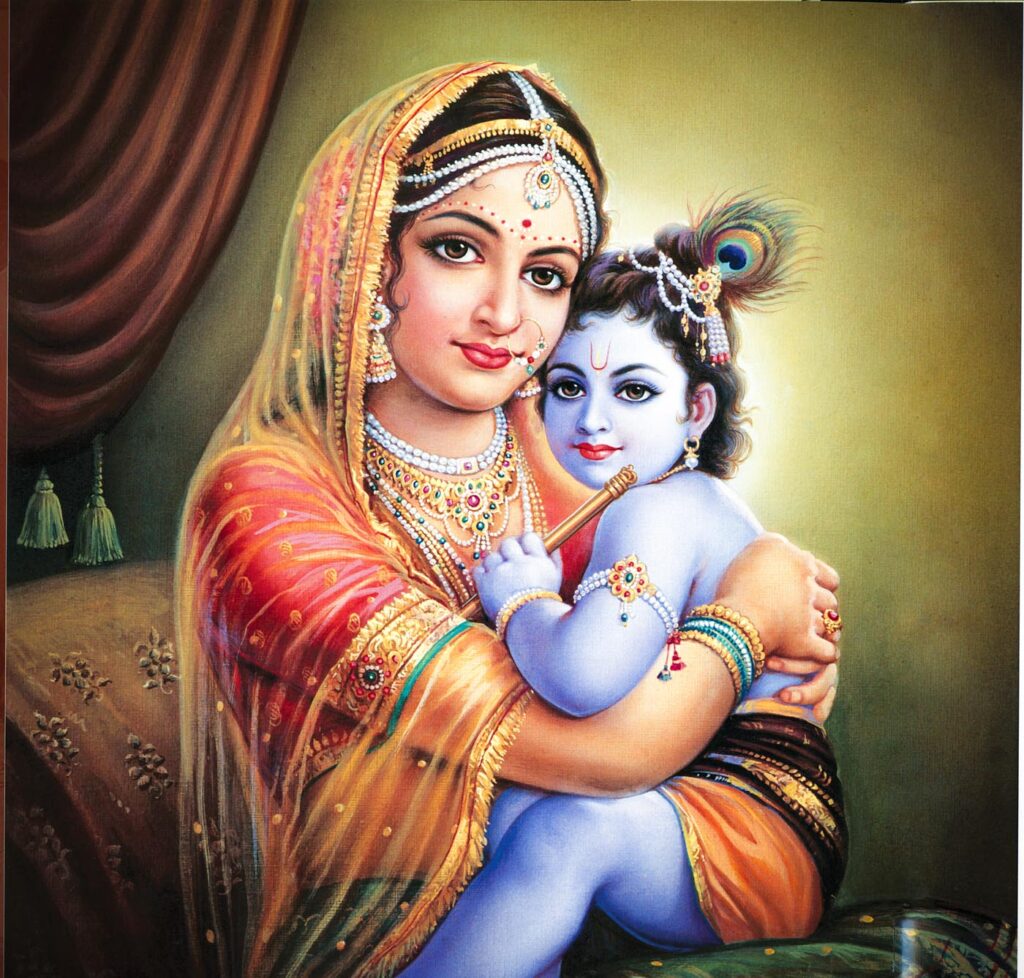
What is Krishna Jayanti?
Jayanti means birth, and Krishna Jayanti is the Lord’s birthday. The festival is also called Krishna Janmashtami, indicating His birth on the eighth day of the waning moon in the month of Shravana (August/September).
What do people do on Krishna Jayanti?
Anticipating the birth of the divine child, devotees prepare their home shrines with images of Krishna decorated with flowers (particularly tulsi) and lavishly adorned with jewels. The whole house is made festive with rangoli designs, lights and fragrant flowers festooning doorways. The discipline is to fast during the previous day and keep an all-night vigil. Families and communities sing and dance late into the night as bards recall Krishna’s youthful antics, His passionate love for Radha and His precious teachings. At midnight, the time He was born, a statue of the infant Krishna is bathed, dressed in new clothes, placed in a cradle and worshiped in an elaborate puja. The fast is then broken, and devotees celebrate and feast for hours. At dawn, women paint baby footprints on the floor leading to the shrine room, a sign that Krishna has entered their home.
How do devotees relate to Krishna?
Interaction with Krishna is always personal. Depending on the devotee, the love inspired by the Divine energy that is Krishna is like that of a mother for a child, a teen for a friend, a lover for a life partner. To many, Krishna is the ultimate mentor and refuge in challenging, soul-searching times. He reminds us of our dharma, or duty, and explains the philosophical choices we have in life. Ultimately, Krishna shows us the path to God Realization.
Tidbits About Lord Krishna
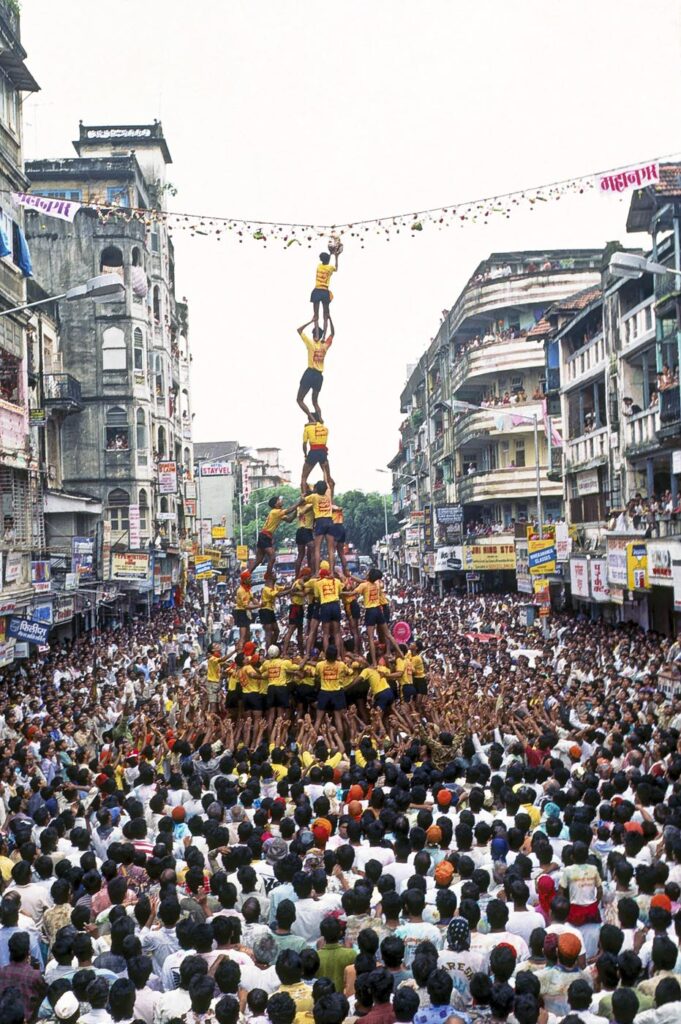
✿ In what ways is Krishna portrayed? Krishna is normally seen as a young cowherd playing a flute, illustrating His days as a carefree youth who whittled reeds into flutes and enchanted the world with music. As an infant, paintings show Him crawling or holding a ball of butter. As a young man, He is the perfect lover. As an adult, He is Arjuna’s wise charioteer on the Mahabharata battlefield. Krishna literally means dark. It is said He is so dark that His skin has a bluish sheen.
✿ Who are the women in Krishna’s life? Radha is the lovely young woman Krishna loved. She represents the devotee, loved by Krishna. Rukmini is Krishna’s soft, gentle and beautiful wife. Satyabhama, another wife, is a brave, daring warrior. On moonlit nights, Krishna dances with the gopis, lovely maiden cowherds. Krishna’s myriad amorous encounters symbolize the infinite capacity of His love, indicating that each of us, no matter how common, can simultaneously be one with the Lord.
✿ What is the handi competition? Reenacting the story of Krishna and His playmates’ absconding with earthen pots of buttermilk, called handi, young men in Maharashtra form human pyramids to reach a high-hung pot of buttermilk and break it with a blunt object, spilling the liquid on all below. Handis are set up in various parts of cities, and teams travel around in trucks competing, as young men do, to break as many as possible, especially those that promise hefty rewards.
Pancha Kajjaya
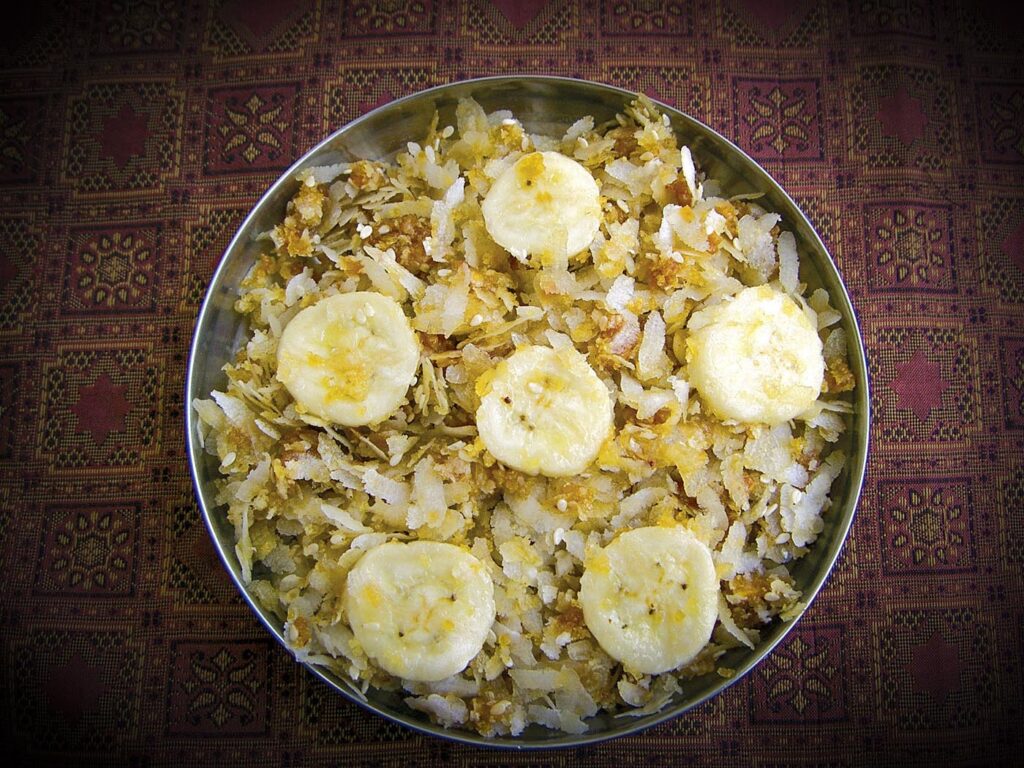
This sweet, crunchy salad is enjoyed as a snack or an exotic side dish
Preparation time: 30 minutes.
Cooking time: 10 minutes
Serves: 6-8
Ingredients
4 cups thin beaten rice (poha)
4 cups grated coconut—preferably fresh, but frozen will work. If using dry coconut, soak in water for 1 hour and squeeze out.
1 to 2 cups powdered jaggery, 4 tbsp white sesame seeds, 1 tsp cardamom powder,
2 tbsp honey
Method
1. Mix rice with the grated coconut and set aside for 30 minutes.
2. Add jaggery, sesame and cardamom; mix.
3. Arrange in a shallow dish and pour about 2 tbps of honey over it.
4. Decorate with thin slices of ripe banana.
Tip: Use only the very thin, light poha. The thicker variety remains hard in the end product and does not absorb the honey.
Fact & Fiction
FACT: It is widely believed that Krishna was an historical figure, though the date of His birth is disputed. Marine archaeologists have recently found compelling evidence of Dvaraka, the capital of His ancient kingdom. Underwater ruins discovered off the coast of Gujarat match descriptions of the city from the epic Mahabharata.
FICTION: A cursory exploration of Hinduism can make it seem superficial, since much of its popular practice, including its festivals, is grounded in a rich treasury of stories, legends and mythology from the Puranas and the epics. In truth, underpinning this delightful literary lore is a deeply mystical nature, vast and comprehensive philosophies, sophisticated systems of yoga and scriptures of peerless profundity.
Holi
Splashed with Colors of Friendship
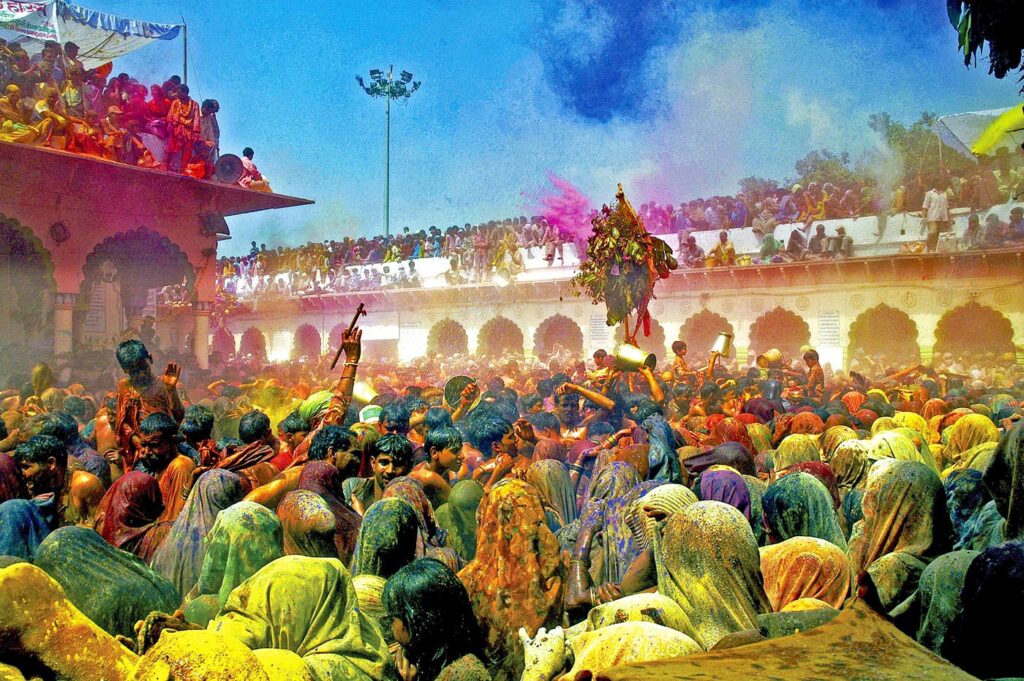
Holi is wild and raucous, a frolic of friendly playfulness. During Holi, India’s streets are overtaken by crowds awash with colored powder. Clothing, faces, arms and hair are smeared and sprayed with every color of the rainbow. People sing, dance, play, hug each other and smile with such childlike joy that it makes one wonder where so much happiness comes from! No religious festival in the world compares to Holi in terms of engaging young and old alike. It is a celebration of love, forgiveness, hope and just plain fun.
What is Holi?
Holi is a community’s exuberant expression of joy to welcome the warmth of spring. In a reflection of nature’s abundance, Hindus celebrate with bursts of color, camaraderie and shared abandon. It begins on Purnima, full moon day, in the Hindu month of Phalguni (February/March) and lasts for as long as 16 days.
How does the festival start?
Many communities create a central bonfire on the night before Holi, starting with kindling and logs and adding organic debris as they clean up their property. The fire symbolizes the torching of negative or troublesome experiences and memories. An effigy of Holika, a demoness personifying negativity, is consigned to the flames, and freshly harvested barley and oats are offered. The embers are collected to light sacred fires, and the ashes are used to mark the forehead as a blessing.
When does the color fun begin?
On the day of Holi, people celebrate by playing, dancing and running in the streets. Water pistols are filled with colored water and squirted on family, friends and strangers alike. Dye powders and water balloons are a big part of the play. The wise wear old clothes, usually white, in anticipation of the mess! Virtually anything goes, including ribald humor, practical jokes and sexual teasing—all excused with the saying, “Don’t mind, it’s Holi!” (Hindi: Bura na mano, Holi hai.) Men are at the playful mercy of women, who dance with them and even dress them in drag. Especially in North India, people celebrate with abandon, even splashing color on their homes as a prelude to the more sober custom of renewing the paint with shell-based white. Deities and images of ancestors are hand-painted and placed in beautiful altars. Dramatic events feature devotional songs and the retelling of the love epic of Radha and Krishna.Bonds are renewed, particularly among in-laws and the extended family. Etiquette on Holi requires that one accept all overtures with an open heart, burying grievances to begin relationships afresh. People of all walks of life mingle and greet, applying vermilion on each other’s foreheads in an uninhibited exchange of goodwill.
What are the delicacies of this festival?
Special sweet and savory treats including mathri, puran poli and vadai are made. Many communities make an intoxicating, cooling drink, called thandai, made of purified water, sugar, seeds of watermelon, muskmelon and lotus, along with nuts, cardamom, fennel, white pepper, saffron and rose petals.
Tidbits About Holi
✿ What is the meaning behind the bonfire? Love, positive values and goodness are celebrated on Holi. Their triumphs over divisiveness and negative forces have been reinforced in legends, such as that of Holika and her brother Prahlad. The famous king Hiranyakashipu had earned a boon that made him virtually indestructible. Blinded by this power, he thought he was God, the only being worthy of worship. His young son Prahlad was devoted to Lord Vishnu and refused to obey his father. Infuriated, the king devised the cruelest punishments. In one attempt, Prahlad’s evil aunt Holika, who possessed the power to withstand fire, tricked him into climbing a burning pyre with her. Prahlad’s love for true Divinity protected him from the flames. Holika burned while Prahlad lived. The bonfire of Holi is symbolic of this victory of good over evil.
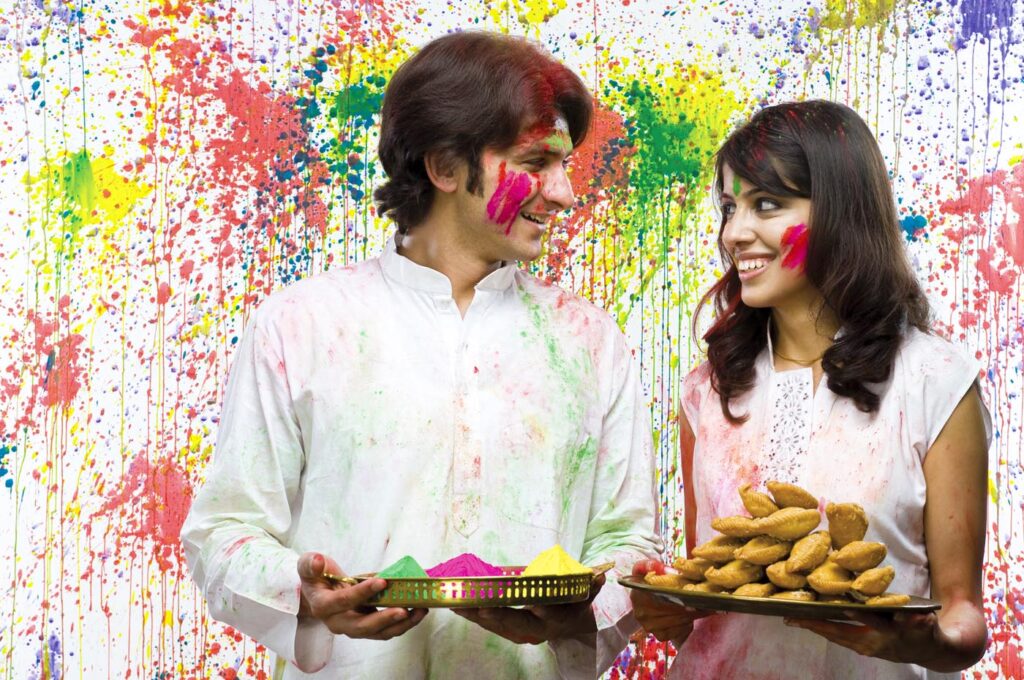
✿ How did the frolicking with color originate? Legend has it that Krishna noticed one day how much lighter Radha’s complexion was than His own. His mother playfully suggested that He smear Radha’s cheeks with color to make Her look like Him, which Krishna did. The strong-willed Radha gleefully retaliated, and a merry chaos ensued. Another legend has it that Krishna celebrated this festival with His friends and the gopis. They danced and frolicked, filling the air with color in a joyous welcome of spring.
✿ Is this a romantic occasion? The festive dancing and camaraderie create the perfect environment for matrimonial alliances. Young people find mates, and families formally seal marital agreements during these days.
Making Safe, Natural Colors
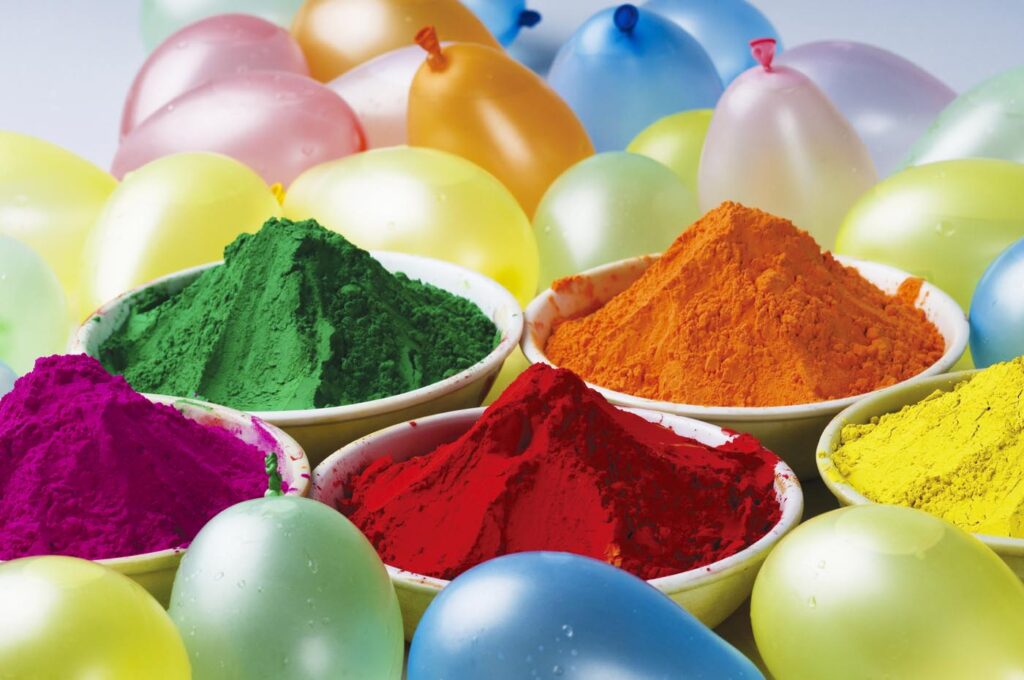
Dyes made of toxic chemicals are too often used during Holi. The food-based recipes below, along with edible food coloring, offer safe alternatives for all colors.
Red: Soak red pomegranate rind in water overnight. A pinch of edible gypsum mixed with turmeric powder in water gives a bright red. Or soak red hibiscus flowers in water overnight.
Yellow: Turmeric powder makes a terrific yellow.
Brown: Soak betel nut in water overnight and dilute as necessary. Or boil tea or coffee in water.
Purple: Boil blueberries in an iron vessel and let stand overnight.
Magenta: Slice or grate one beet root. Leave overnight in water. Dilute as needed for different shades.
Green: Purée spinach, coriander or mint leaves in water. Strain and use.
Fact & Fiction
FACT: Hindus worship and celebrate the Divine with unparalleled variety and fervor. Dance, song, prayer, meditation, processions, pilgrimage, bathing, painting, symbols and rituals are all valid ways of connecting with Divinity. This is living testimony to the existence of many paths within this ancient faith, all leading to God. Each person finds his own path among the many laid out by gurus and sages. To the Hindu, spiritual life is meant to be lived joyously, as Holi demonstrates.
FICTION: Hinduism is rich with stories of the Gods and their wives. On a deeper, philosophical level, it is widely regarded as a fiction that the Gods are married. The Supreme Being and the Gods are neither male nor female and are therefore not married.
Vaikunta Ekadashi
When Heaven’s Doors Open Wide
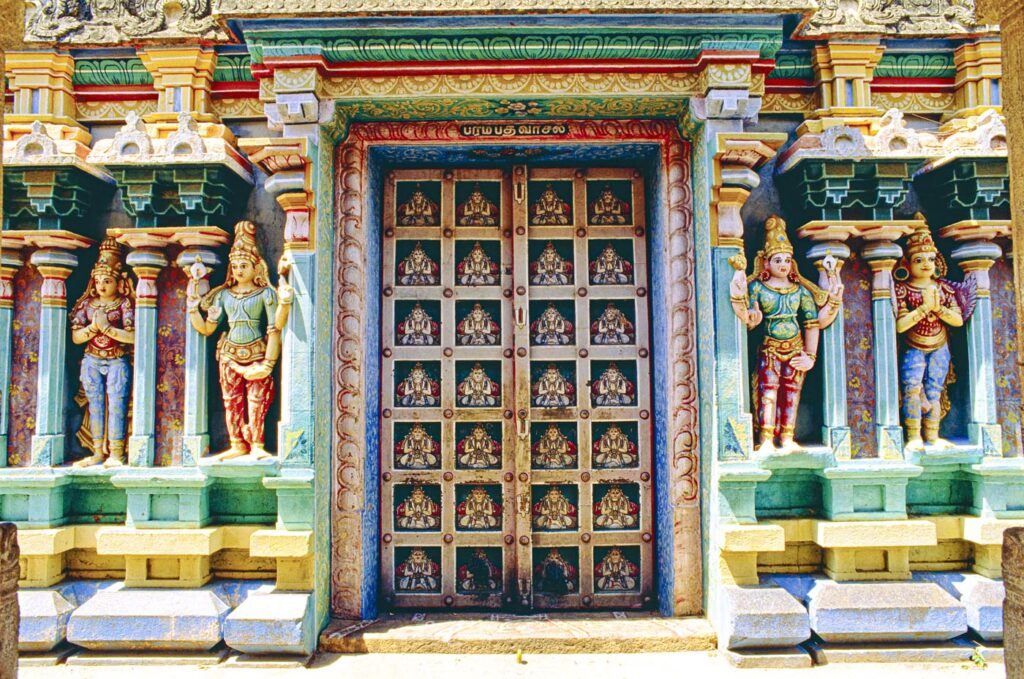
To those with a pure heart, the gates of Vishnu’s spiritual world are always open. But on a precious few days, it is said, that passage is open to all, allowing devotees to more easily reach Vaikunta, the abode of Lord Vishnu, Supreme God to hundreds of millions of Hindus. This is the essence of Vaikunta Ekadashi, a festival marked by fasting, devotion and pilgrimage to famous temples, when devotees draw closer to God in a most personal way.
Who is Lord Vishnu?
In the Vaishnava sect of Hinduism Vishnu is the Supreme God, venerated as the all-pervading essence of all beings, the master of time, the One who supports, sustains and governs the universe and all elements within it. In the sacred Puranas, Vishnu is described as the color of dark blue clouds, having four arms and holding a lotus, mace, conch and a chakra. Through the ages, He manifests in several forms, or avatars, such as Sri Rama and Sri Krishna, to guide humans on the path of dharma. Vishnu’s constant companion is the Goddess Lakshmi. He represents the potential and She the wealth of potential brought to fruition.
What is Vaikunta Ekadashi?
Ekadashi is the eleventh lunar day of every fortnight. Of the two dozen ekadashis in a year, Vaikunta Ekadashi reigns supreme. It is known as Mokshada, “bestowing liberation.” On this day, the doors to Vishnu’s divine abode, called Vaikunta, are open wide to all who seek salvation, moksha. This occurs in the bright fortnight of December/January, the Hindu month of Mrigashira. According to mythology, devas and demons churned the Ocean of Milk for 1,000 years and amrita, the nectar of immortality, appeared on this day.
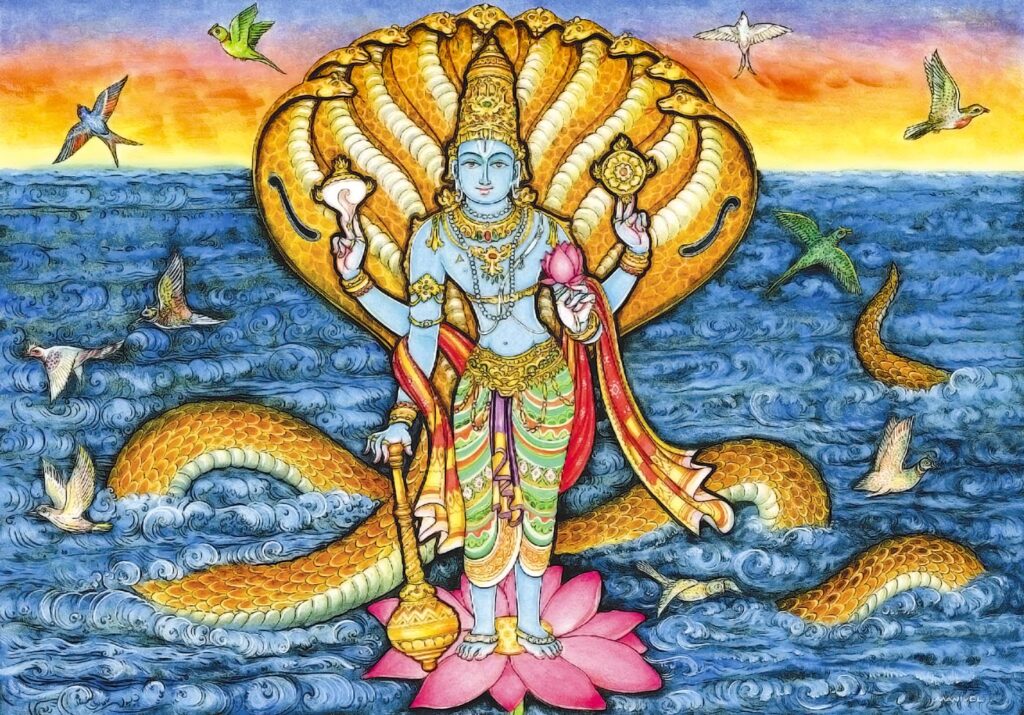
What do Hindus do on Vaikunta Ekadashi?
Devotees maintain a total or partial fast and observe mauna, silence, while remembering Vishnu in prayer. While many Hindus fast on all ekadashis, Vaikunta Ekadashi is observed with utmost diligence and self-restraint. A common observance is to consume only water or milk.
What are the temple observances?
Devotees flock to Vishnu shrines, especially famous ones such as the Venkateshwara temples in Tirupati and Pittsburg, and the Ranganathar temple in Srirangam, where the festival spans 21 days, divided into morning and night observances. Lord Vishnu, adorned in diamond-studded armor, is brought to a 1,000-pillared hall through the northern gate, called swarga vasal, “heaven’s entrance,” which is opened only this one time each year.
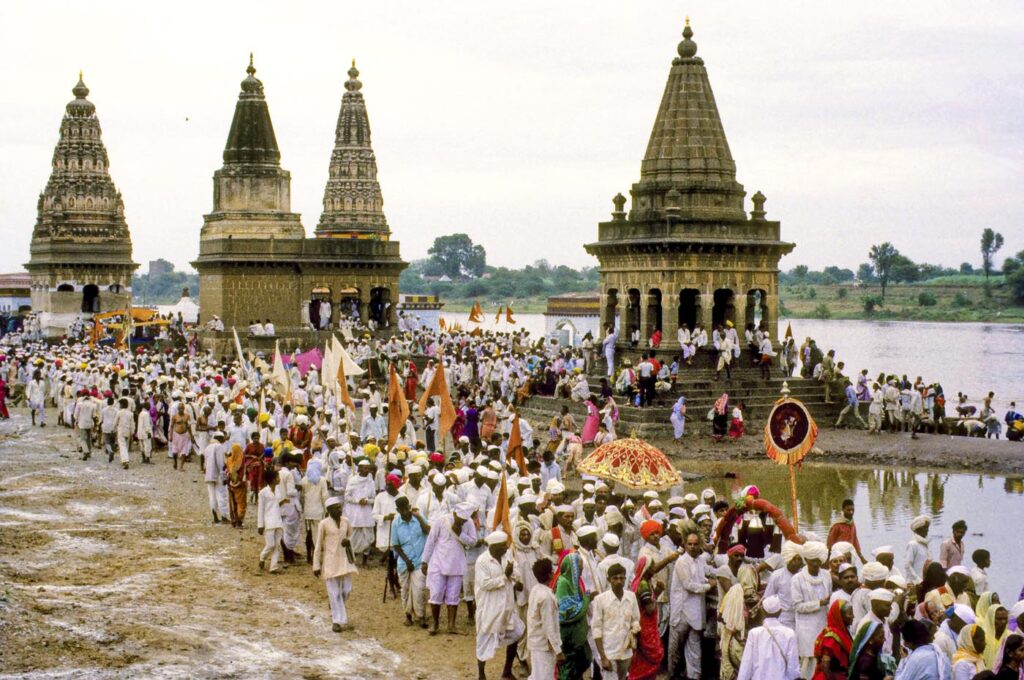
What else is celebrated around this time?
In the northern hemisphere, winter solstice occurs in this month, heralding longer, warmer days and agrarian prosperity. This transition to the year’s fortuitous half is celebrated with beautiful patterns, called rangoli, drawn with colored rice flour on the floor outside homes. Hindus believe that at this time the divine celestials are most attentive to the pleas of mankind. Devotees rise early, perform ablutions and, throughout the month, visit temples with prayers in heart and gifts in hand.
Tidbits About Vaikunta Ekadashi
✿ What is the legend of Ekadashi? In an ancient story, Ekadashi is a devi, or angel, born of Vishnu’s mind, a fierce defender of righteousness, a protectress of those in need. Strengthened by unfailing devotion to God Vishnu, she was feared by the forces of evil and ignorance. Vishnu offered her the boon of being rich, famous, powerful and beautiful in the world of mortals. But she declined, saying she wanted only to share her blessings with humans who fast and pray to Him on ekadashi. Vishnu granted her wish, decreeing that anyone worshiping Him by fasting on the eleventh day of the moon would be allowed access through the celestial gates. In the epic Mahabharata, Lord Krishna relates Ekadashi’s story to King Yudhishthira, praising her and recommending fasting as an ancient and effective spiritual practice.
✿ How is the fast broken? The Ekadashi fast is normally broken the next lunar day, dvadashi, by partaking of fruit, herbs and milk. The Indian gooseberry, amla, known as a wonder food, is eulogized in the Puranas as the ideal nourishment to jump-start the system after a fast.
Does Religious Fasting Make Sense?

Fasting in Hinduism indicates the denial of the physical needs of the body for the sake of spiritual gains. According to scripture, fasting helps create an attunement with the Absolute by establishing a harmonious relationship between the body and the soul. By fasting, the devout exercise control over their rioting senses and desires. It is a sacrifice made to the Self, by the self.
By turning within in meditation, they rein in the mind. Since the body is mostly composed of fluids, it is influenced by the phases of the moon, as is the mind. The rishis, ancient Hindu scientists, established these connections and recommended fasting and meditation based on the moon cycle, such as on ekadashi. This causes a natural slowing down of the system and the opportunity to reconnect with one’s deeper being.
Fasting breaks life’s repetitious regimen and brings clarity, empowering the individual to resume normal activities with greater vigor and conviction.
Hinduism: Fact & Fiction
FACT: Science and mysticism have long blended in Hindu tradition. The ancient sages who wrote down the scriptures also made observations on astronomy, time and mathematics. Long before Galileo, Copernicus and Newton, Hindus recorded knowledge of gravity, heliocentrism and other universal laws in treatises called Siddhanta. Hindu rishis further explored the connections between mind, body and the soul, evolving the sciences of yoga and ayurveda for a rewarding, beneficial life.
FICTION: Western scholars describe Hinduism as polytheistic. This is incorrect. While Hindu scriptures speak of many Gods—as many as 330 million—there is only one Supreme Being worshiped under different names by Hindus of various denominations and linguistic backgrounds. The One Great God created lesser Divinities, suprahuman beings presiding over aspects of Creation, not unlike the archangels of Christianity. Hinduism is neither polytheistic nor pantheistic; its philosophy is rightly called panentheism, God in all things and yet beyond.
Skanda Sashti
Approaching the Lord of Illumination
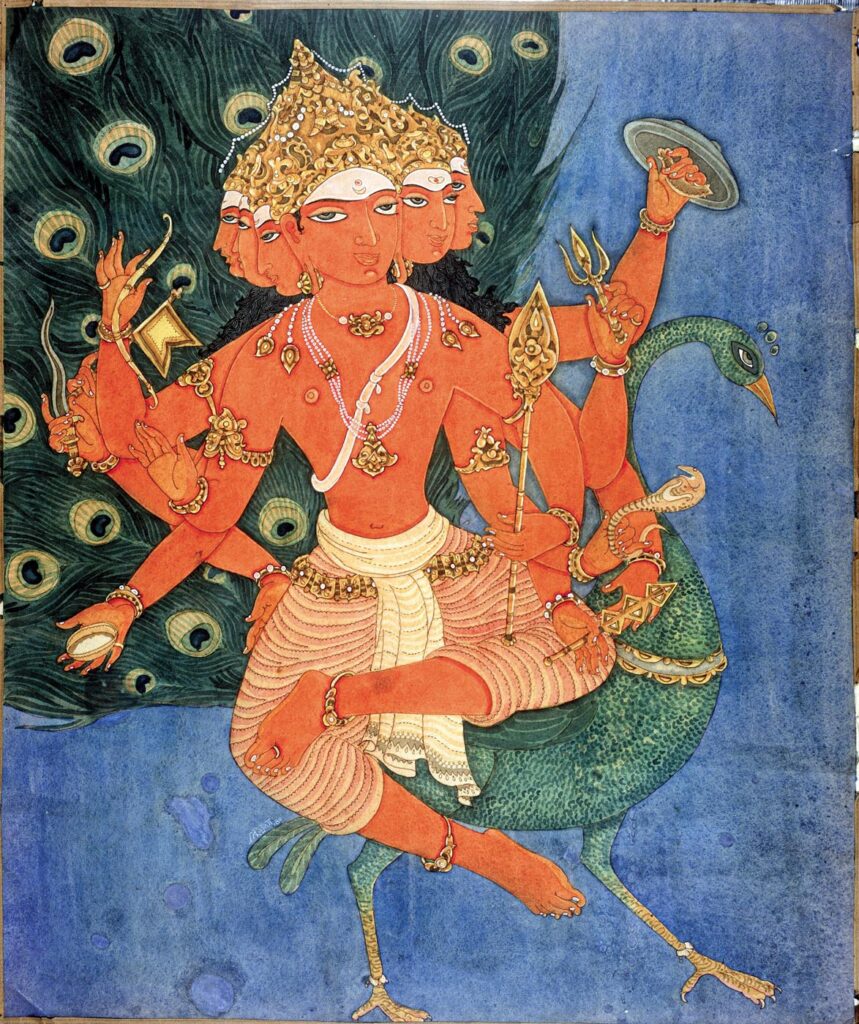
Skanda Sashti is a six-day South Indian festival to Skanda, the Lord of Religious Striving, also known as Murugan or Karttikeya. It begins on the day after the new moon in the month of Kartika (October/November) with chariot processions and pujas invoking His protection and grace. The festival honors Skanda’s receiving His lance, or vel, of spiritual illumination, and culminates in a victory celebration of spiritual light over darkness on the final day. Penance, austerity, fasting and devout worship are especially fruitful during this sacred time.
Who is Skanda?
Skanda is a God of many attributes, often depicted as six-faced and twelve-armed. Saivite Hindus hail this supreme warrior, the commander-in-chief of the great army of devas, or beings of light, as a fearless defender of righteousness. They honor Him as the mystic healer of ailments and master of yoga, guiding those who persevere on enlightenment’s path. Legends say He was the first to renounce the world and step onto the path of kundalini yoga. God Siva bestowed upon His son Skanda dominion over the chakras of willpower, direct cognition, and the purest, childlike divine love. Murugan is the tutelary Deity of the Tamil community.
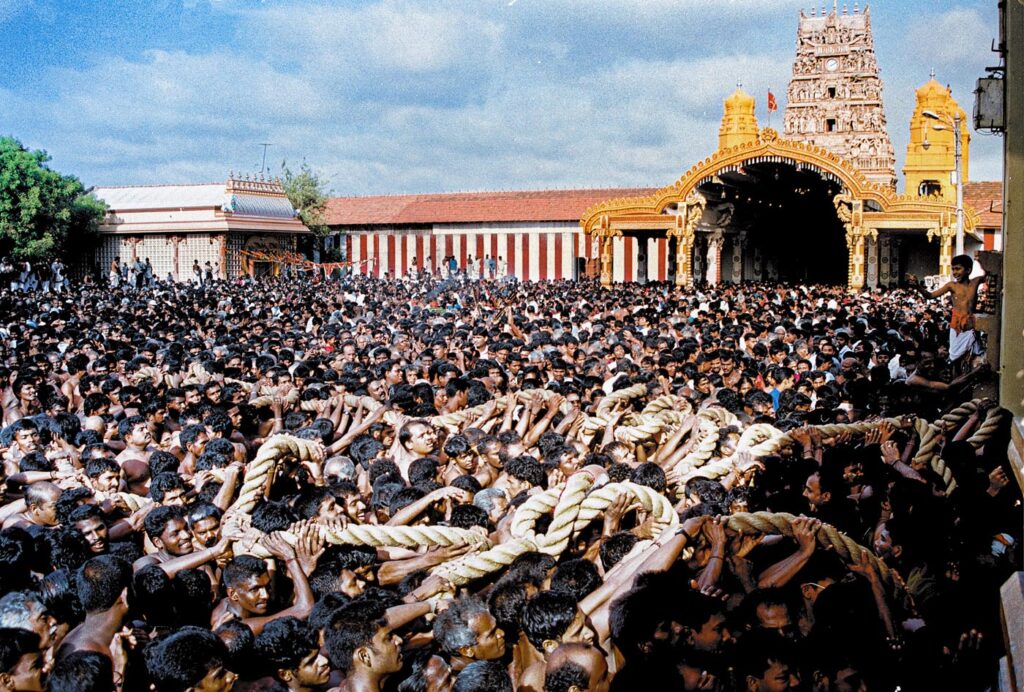
How is Skanda Sashti celebrated?
It is considered meritorious to undertake a six-day fast, known as the Skanda Sashti Vrata, or vow, in empathy for Skanda’s titanic struggle. Many abstain from all foods, while some permit themselves fruits and simple, unsalted foods. Following immediately after Diwali, the fast is an ideal antidote to that festival’s feasting, revelry and overindulging. On the day the fast is broken, families enjoy a sweet pudding called payasam along with fried delicacies. A six-part prayer for protection, called the Skanda Sashti Kavacham, is chanted. Six is a number associated with this God. Another discipline is to stand in a river, facing upstream, draw a six-pointed star and write “Saravanabhava,” His supreme mantra, on the water before doing ablutions. Special decorations adorn home shrines, featuring images of the peacock and the fighting rooster. Devotees pilgrimage to Murugan’s temples, especially Nallur in Sri Lanka, the temple in Lanham, Maryland, and the seaside sanctuary at Tiruchendur in South India.
What is the legend of Skanda Sashti?
It is said that eons ago Skanda fought a powerful asura, or demon, named Surapadman, who embodied the forces of selfishness, ignorance, greed and chaos. Skanda defeated and mastered those lower forces, which He uses, to this day, to the greater good. The subdued demon became his faithful servant, the proud and beautiful peacock on which Skanda rides.
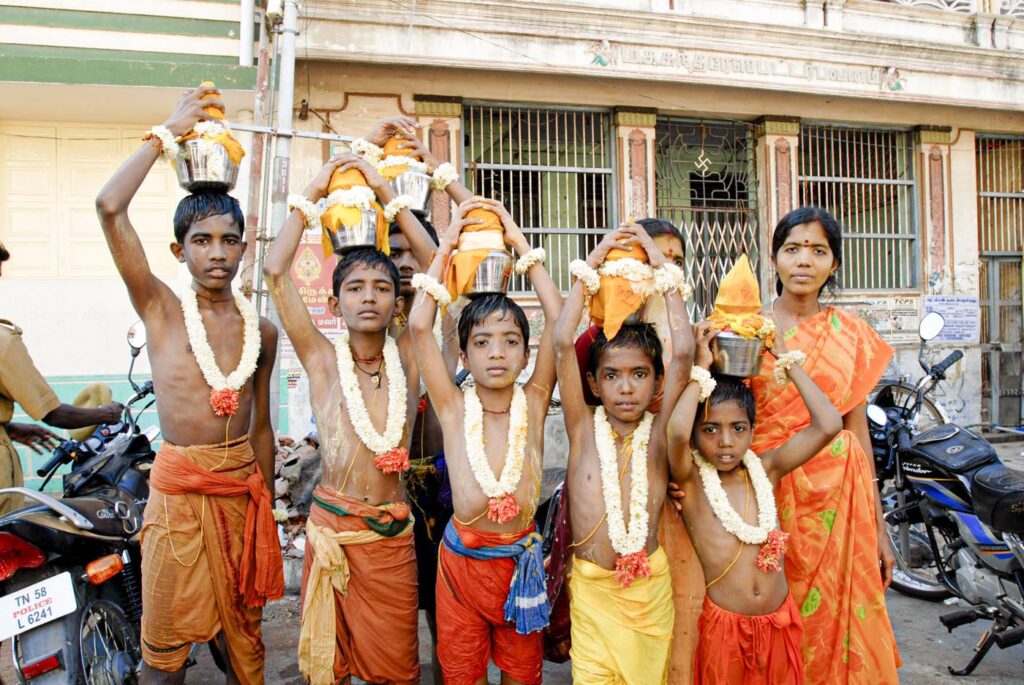
What happens on the sixth day?
In Murugan temples, the Deity is worshiped with oblations of special unguents, milk and other offerings. Crowds gather to watch a dramatic play depicting the conquest of Surapadman. Millions flock to see this drama performed on the beaches of Tiruchendur, where the legendary battle occurred.
Tidbits About Skanda and His Festival
✿ What else occurs on these holy days? This festival is associated with a unique tradition of giving, dana. A young, unmarried male student, brahmachari, is invited to the home, served a sumptuous meal with special sweets and honored with gifts of new clothing (usually a traditional unstitched cotton veshti), betel leaf, betel nut and fruits. This boy represents the youthful Murugan, and service to one is service to both.
✿ Why does Skanda bear weapons? Hindu iconography is rife with fighting implements. Skanda, general of the heavenly army, wields weapons which symbolize His manifold powers. These battle arms represent forces He uses in the subtle realms of the mind, piercing the veils of ignorance, rescuing those in distress and defending righteousness. He is called the Great Protector.
✿ What does His lance signify? The lance, or vel, embodies discrimination and spiritual insight. It stands for release from ignorance into knowledge, from sinfulness into purity through spiritual austerities.
Kesari
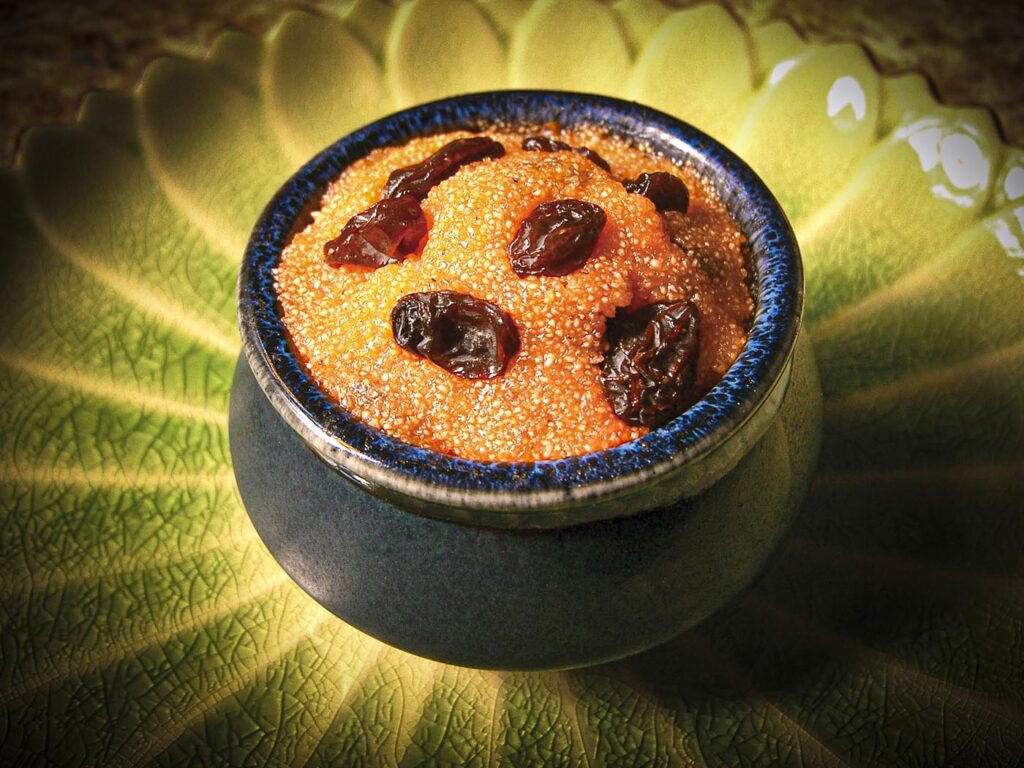
This quick and easy sweet semolina-based dish gets its name from kesar, or saffron, which gives it a bright orange hue.
Preparation time: 10 minutes
Cooking time: 10 minutes
Serves: 4
Cooking equipment: a wok, a large spoon and a plate.
Ingredients
1 cup semolina, 2½ cups hot water,
5 tbsp ghee, ½ to 1½ cups sugar,
½ tsp cardamom powder (or fresh ground), a pinch of saffron or kesari powder,
2 tbsp raisins, 2 tbsp cashews
Preparation
1. Heat the water and add the saffron, cardamom and sugar to steep.
2. Heat 2 tbsp of ghee, fry cashews and raisins, drain and set aside.
3. Mix semolina with remaining ghee. Cook, stirring until light brown. Remove from heat.
4. Slowly add the semolina to the hot water, mixing continuously to prevent lumps.
5. Return to very low heat and cook for five minutes, still stirring until the whole mass comes together like a ball and does not stick to the spoon.
6. Transfer to a serving dish.
7. Garnish with fried raisins, cashew nuts and a sprinkle of saffron.
Hinduism: Fact & Fiction
FACT: In ancient days Hindu culture spread peacefully throughout Southeast Asia and west towards Greece and Rome via political ambassadors, traders, saints and travelers. Many communities and individuals beyond India’s shores adopted the Hindu way of life by choice.
FICTION: Hindus are sometimes disparaged as “idol worshipers” by those seeking to belittle their faith. In fact, Hindus do not worship a stone or metal idol as God. They worship God through the image, invoking God’s presence into the image from the higher, unseen worlds, so as to commune with the Divine for blessings and upliftment. Image worship may be likened to using a telephone to converse across long distances with someone: one is not talking to the telephone.
Sankranti or Pongal
To Earth, a Festival of Thankfulness
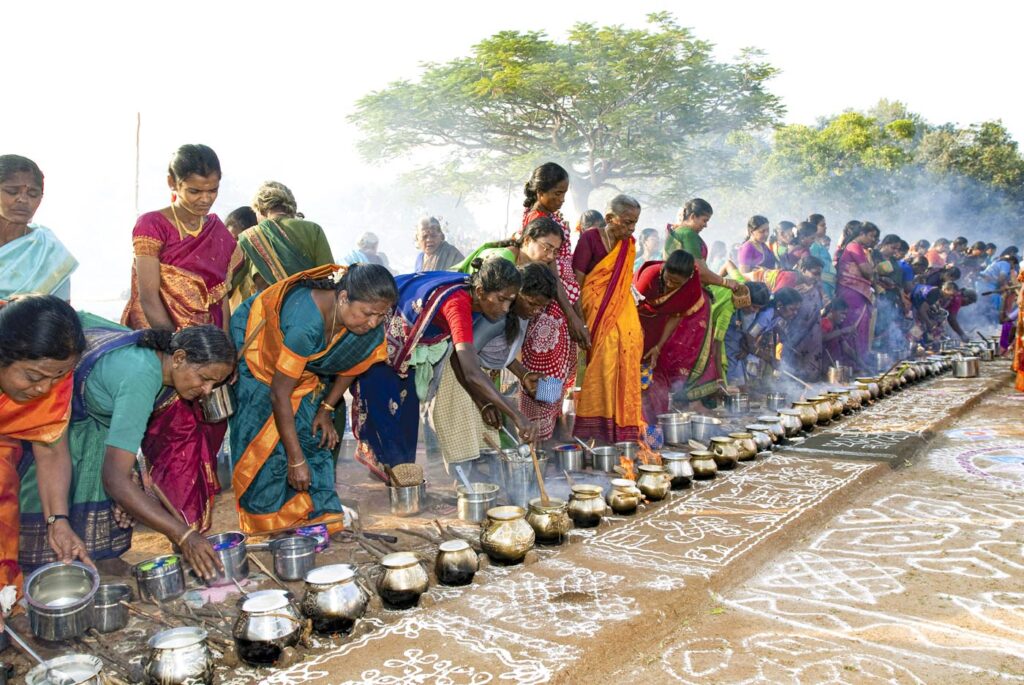
Hindus acknowledge the sacredness of Earth and all life. Nature is a creative force worthy of respect, even veneration. Each year at harvest time, agrarian communities all over India celebrate this festival with enthusiastic abandon. They dance, fly kites, sing and exchange gifts in a grand thanksgiving celebration.
What is the nature of this festival?
Makara Sankranti (“transition to Capricorn”) is four days of giving thanks to four great forces of influence and protection: Indra, the giver of rain; Surya, the Sun; gracious cattle and beloved ancestors. This happy occasion is known as Pongal by Tamils, Pedha Panduga among the Telugus and Lohri by Punjabis. It begins on the day the Sun enters Makara (Capricorn), between January 13 and 15. This is a special time of giving blankets, pumpkins, sugarcane and other items to the poor. Married women are honored, and gifts are given to newborn children.
What is done on the first day?
The day before festivities begin, Hindus thoroughly clean their homes, discarding unwanted, worn out or broken items and obtaining replacements for the year ahead. This clears away stale, negative energy and brings an influx of dynamic blessings into the home. It is a time for clearing the mind as well, to begin the year with focus and confidence. On the first day, Indra, the celestial power of lightning and rain, is worshiped.
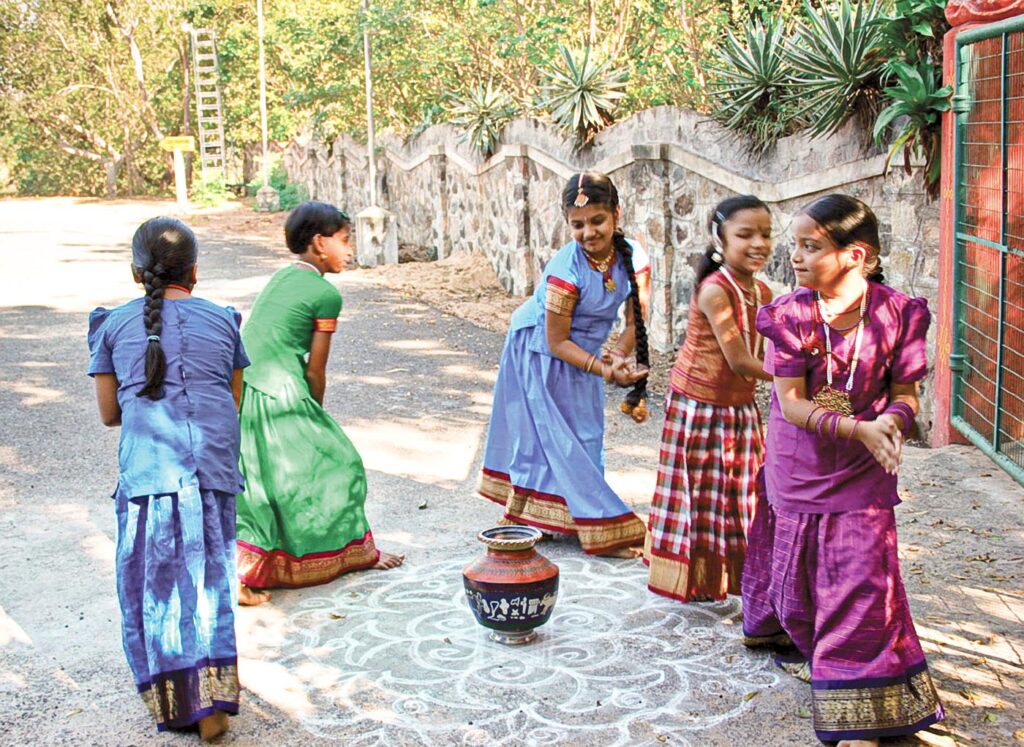
What happens on the second day?
Using colored rice flour, women draw patterns on the floor called kolam or rangoli, depicting the Moon and the Sun in a chariot. Prayers are directed to Surya with offerings of freshly harvested sugarcane and vegetables. The main event happens at sunrise, when everyone gathers in a gaily decorated compound where freshly harvested rice is cooked with milk in a new pot. In Tamil communities, the moment the pot boils over, all shout, “Pongalo Pongal!” (“It’s boiling over!”). All watch to see whether the froth overflows toward the East, which auspiciously indicates abundance for the year ahead. Conches are sounded and children dance for joy. A portion of the boiled rice, the season’s first food, is offered to Mother Earth as a gesture of gratitude, and to all creatures and nature spirits. The remainder is eaten by the families. Wearing new clothes, families visit one another, exchanging gifts and enjoying feasts.
What happens on the third day?
On the third day, Hindus offer thanks to cattle, the farmer’s gracious helpers. Bulls and cows are lovingly adorned with cowrie shells, embroidered shawls, colorful ropes and bells. They are fed sweet rice and sugar cane.
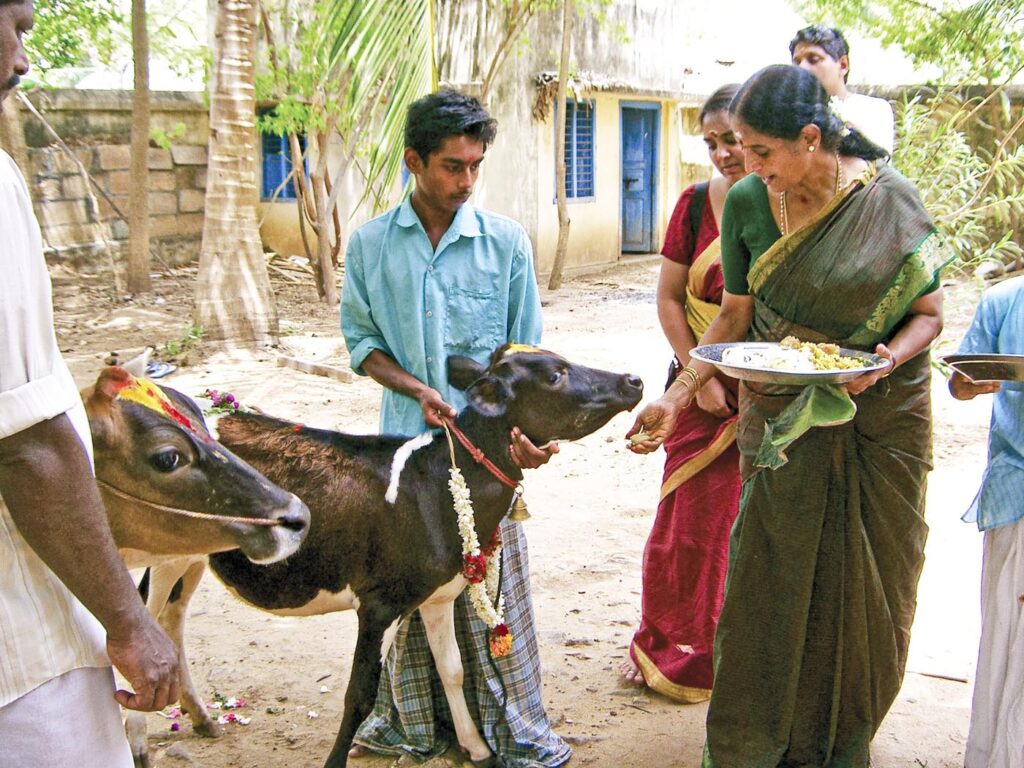
How is the final day celebrated?
On the fourth day, ancestors and wildlife are venerated. It is a day for picnic outings and family visits. Young girls and women receive blessings from older women for happiness and prosperity. Youth honor their elders. Brothers and sisters exchange gifts and express mutual respect and allegiance. Poets and their works are revered. In Tamil Nadu, it is also called Tiruvalluvar Day, in honor of the author of the famed ethical scripture Tirukural.
Tidbits About the Harvest Festival
✿ Why is the harvest festival so important? The months before the harvest considered an inauspicious time, are fraught with anxiety for farmers and for society. All celebrations, such as weddings, are held off. Months of toil in the fields and uncertainty over the harvest come to an end with Makara Sankranti. The harvest brings prosperity. Agrarian communities all over India celebrate this festival with enthusiastic abandon. Once the crops are harvested and cash flows in, communities proceed to plan weddings and other rites of passage. Over one quarter of the Rig Veda is devoted to praises of Indra, the lord of the elements, the exalted Lord of the devas and God of rain, who is essential to the yield.
✿ Are there other festivals during this month? In the Bhogi bonfire, communities heap and burn organic, agricultural waste accompanied by festive dancing to drums. During Kummi, a folk dance is performed by children, twirling and clapping around a pot to simple poetry chanted in a sing-song manner. For Gombe Ellu, children carry dolls as they visit neighbors with offerings of ellu bella, “trail mix” made of desiccated coconut, jaggery, sesame seeds and peanuts. They give and receive treats, learning from a small age the value of community sharing.
Sakkarai Pongal
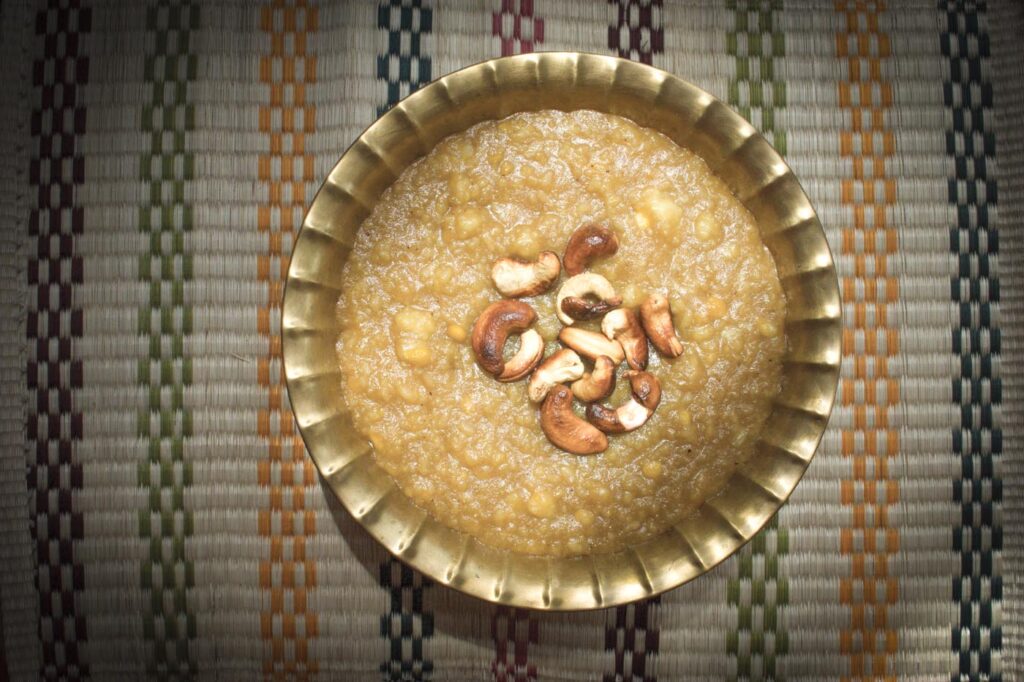
This recipe for sumptuous sweet rice is from Jaffna, Sri Lanka
Preparation time: 10 minutes
Cooking time: 55 minutes
Serves: 4
Equipment: a medium pot, a skillet and a big spoon
Ingredients
2 cups rice, 1/4 cup raisins, 2 tbsp mung dal, 1 tsp cardamom powder,
2/3 cup sugar, 3/4 cup freshly grated coconut (or frozen grated coconut), 1/4 cup cashews, 1 tbsp ghee
Method
1. Roast mung dal in a dry skillet until it is golden brown.
2. Boil rice and mung dal in five cups of water for thirty minutes, until the rice is cooked.
3. Add sugar and coconut and stir well. Reduce heat and simmer for 10 minutes.
4. Fry raisins and cashews in ghee until nuts are light brown, then add them to the rice along with the cardamom powder.
5. Stir well & remove from heat.
Hinduism: Fact & Fiction
FACT: Hinduism places great emphasis on giving. Dana, charity or giving, is one of the tenets of yoga. Hindus are encouraged to give to the poor, to holy men and to religious institutions. The Tirukural inquires, “The benevolent expect no return for their dutiful giving. How can the world ever repay the rain cloud?” Dashamamsha, or tithing, giving one-tenth of income to the religious institution you are affiliated with, is an ancient Hindu practice.
FICTION: It is commonly thought that all Hindus believe God occasionally incarnates as an earthly being, called an avatar. In fact, this doctrine is specific only to some denominations and traditions.
